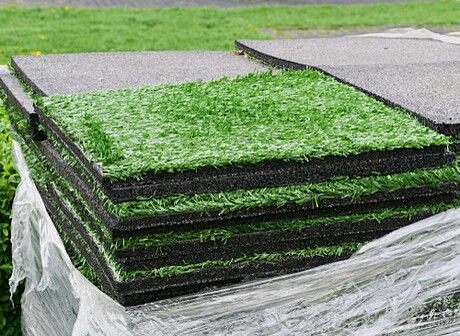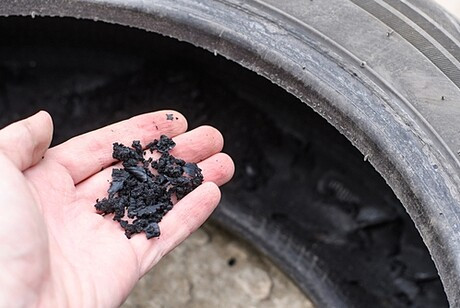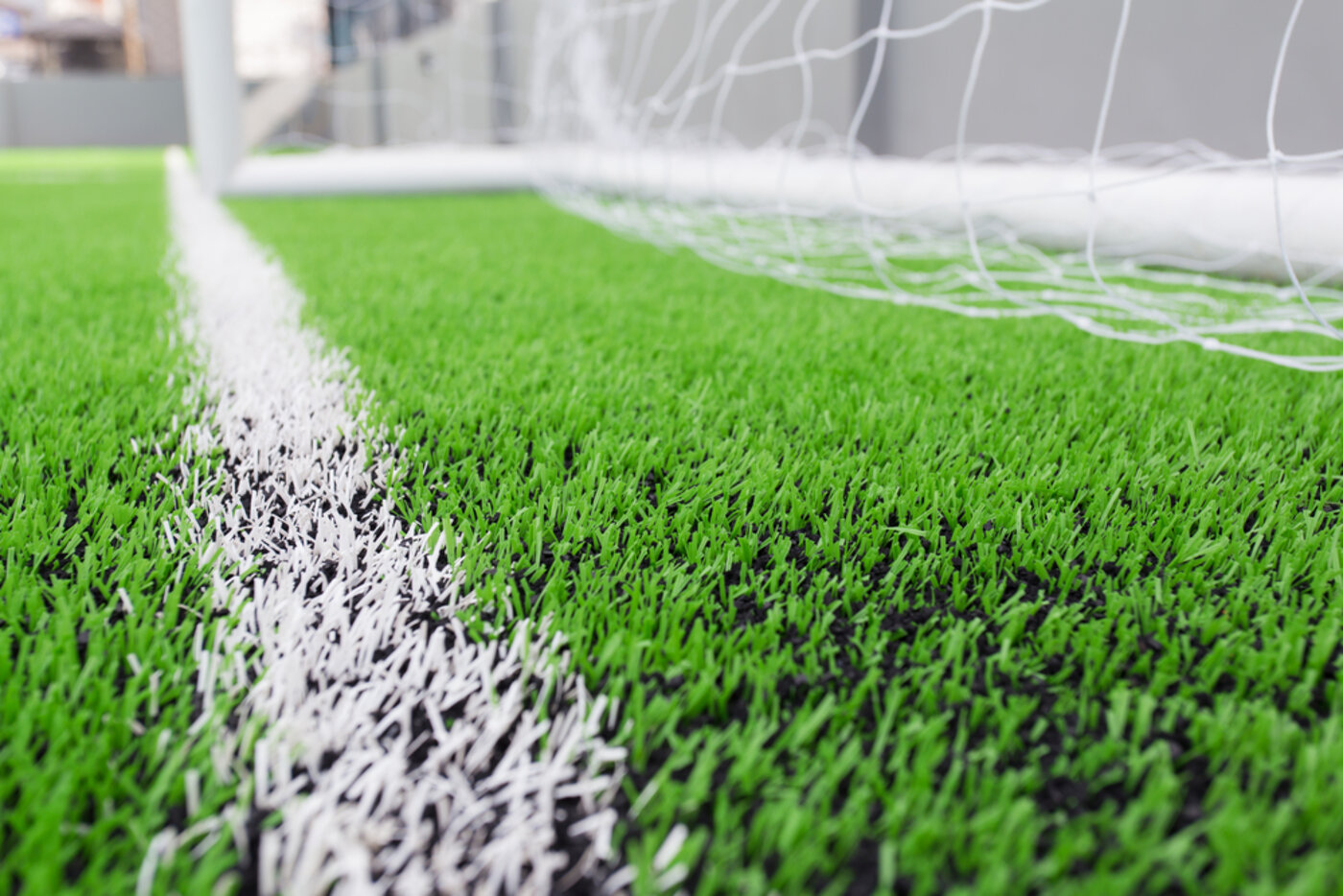Thousands of artificial turf systems have been installed in communities across North America and Europe. A US EPA presentation in 2019 noted that there were about 12,000 to 13,000 artificial turf fields in place at the time, with approximately 1,200 to 1,500 additional artificial turf fields installed each year.1
A 2020 report by the Synthetic Turf Council, an industry association, estimated the area of installed artificial turf in North America at 265 million square feet.2 Tens of thousands of artificial turf systems have been installed in Europe as well.3 While communities continue to consider installation of artificial turf in additional locations, many aging artificial turf systems are coming to the end of their useful lives and will require disposal and replacement.
Rubber and Plastic Pollution
 Artificial turf is a plastic and rubber product composed of several layers. These include carpet and fibers (artificial grass blades made from plastic); infill material that provides cushioning and helps hold the carpet fibers upright; a shock pad in some cases; and a base layer, including a drainage system.
Artificial turf is a plastic and rubber product composed of several layers. These include carpet and fibers (artificial grass blades made from plastic); infill material that provides cushioning and helps hold the carpet fibers upright; a shock pad in some cases; and a base layer, including a drainage system.
Several parts of an artificial turf system generate plastic pollution as the product degrades over time. Rubber or plastic particles migrate off the artificial turf area and into surrounding areas; parents and residents living near artificial turf fields have collected photographic evidence of waste tire particles dispersed in wetlands and filling storm drains.
Plastic grass blades pollute water resources and gradually break down into increasingly small pieces. A 2023 study conducted in Spain analyzed the presence of artificial turf fibers in river and ocean surface waters.4 The artificial turf fiber materials found in ocean water appeared in various sizes, and included micro-, meso-, and macroplastics (under 5 millimeters, 5-25 millimeters, and over 25 millimeters, respectively). The researchers found that artificial turf can be a significant source of plastic pollution in water. Based on their sampling, they found that artificial turf fibers “can represent a high proportion (i.e. over 15%) of the plastic debris in aquatic environments, especially on the sea surface and within the meso- and macroplastic size range in our samples.” They note that “up to 20,000 fibers per day flowed down through the river” that was examined in this study.
In September 2023, the European Union (EU) adopted a regulation restricting the sale of “synthetic polymer microparticles” (frequently referred to as microplastics).5 The regulation specifically includes “granular infill for use on synthetic sports surfaces.” The requirements for infill go into effect eight years after the regulation enters into force (see this document for details). Some researchers have recommended that other countries should follow the EU model for addressing microplastics, including those used in artificial turf.6
Health Concerns
Chemicals
A variety of concerns have been raised about chemicals in artificial turf, including chemicals in infill as well as carpet blades and backing.
 Waste tires are often used in infill. Waste tire material contains a variety of toxic chemicals, including polyaromatic hydrocarbons (PAHs); metals such as lead and cadmium; antiozonants such as 6-phenylenediamine (6PPD); and a range of other chemicals, including vulcanization compounds, stabilizers, and fillers. Some of these chemicals are known or suspected carcinogens; others are associated with asthma, endocrine disruption, and other health effects.
Waste tires are often used in infill. Waste tire material contains a variety of toxic chemicals, including polyaromatic hydrocarbons (PAHs); metals such as lead and cadmium; antiozonants such as 6-phenylenediamine (6PPD); and a range of other chemicals, including vulcanization compounds, stabilizers, and fillers. Some of these chemicals are known or suspected carcinogens; others are associated with asthma, endocrine disruption, and other health effects.
Other materials used as infills include other types of rubber or plastic; mineral-based materials such as sand or zeolite; and plant-based materials including wood, coconut fibers, and cork, among others. A 2020 review of infill materials found that some alternative materials are likely to be preferable to waste tires, but did not identify any that were entirely free of concerns.7 For example, alternative rubber and plastic products can also contain a variety of toxic chemicals, and zeolite poses inhalation hazards.
Testing has shown the presence of per- and polyfluoroalkyl substances (PFAS) in artificial grass blades (carpet fibers) and carpet backing.8
Many studies have been conducted on artificial turf. Many of these are materials characterization studies, which seek to determine what chemicals are present in the product. Others are risk assessments, in which researchers have attempted to estimate possible disease risk associated with exposure to artificial turf. Risk assessments are an estimate of excess disease risk that rely upon assumptions about exposure and other factors. Risk assessments for artificial turf have yielded variable results depending on the chemicals and the exposure scenarios considered, among other factors.9 In general, the results of risk assessments can vary substantially depending on the data and assumptions that are incorporated into the study.10 Some toxicology studies have also been conducted on waste tire materials; these provide additional insights into possible health effects of the mixture of chemicals found in waste tires (for one example, see Xu et al. 2019).11
In interpreting the studies that have been conducted to date, it is important to be aware of the particular vulnerability of children and adolescents to the effects of toxic chemicals. Children breathe more air per unit of body weight than adults, and have more hand-to-mouth exposure to environmental contaminants than adults. Children’s and adolescents’ organ systems are developing rapidly and their detoxification mechanisms are immature. A toxic exposure that occurs during childhood or adolescence can have a much greater effect than a similar exposure that occurs during adulthood. For these and other reasons, it is particularly important to protect young people from toxic exposures – whether these occur in a play environment, at home or at school, or from other sources. In all these settings, it is important to reduce or eliminate toxic exposures wherever possible.
Sports players have raised concerns about a possible link between exposure to waste tire materials in artificial turf and cancer. To date, this concern has not been investigated in a robustly designed epidemiological study, so there is a lack of knowledge about this concern. For a recent overview of the debate about cancer and artificial turf, and the lack of research on the topic, see this investigative reporting piece by journalist Stephen Howie.12
It is important to note that epidemiological data is not necessary in order to take precautionary action to protect children and adolescents from preventable toxic exposures. We know that artificial turf contains chemicals of concern, and natural grass fields are a feasible and safer alternative.
Heat hazards
On a warm, sunny day, artificial turf can become much hotter than natural grass.13 Surface temperatures can rise to 120 or even 180 degrees F, depending on weather conditions.14 Researchers have found that all artificial turf becomes hotter than natural grass, regardless of the materials used as infill.
The artificial grass blades play an important role in trapping heat (see this overview by Penn State’s Center for Sports Surface Research).15 High temperatures can burn skin, damage shoes, and increase young athletes’ risk of serious heat-related illnesses.
Microplastics
Microplastics are a source of growing concern in the scientific community. A recent review of the scientific literature by the California State Policy Evidence Consortium concluded “microplastics are suspected to promote deleterious human health effects in the reproductive and digestive systems,” among other human health concerns.16
Disposal Concerns
Artificial turf fields generally last for about a decade. After this point the turf – tens of thousands of pounds of material per field – has to be disposed of and replaced.
Recycling is a challenge for the artificial turf industry. Investigative journalists have uncovered multiple examples of large quantities of waste athletic turf being stockpiled informally. A 2019 investigation by the York Daily Record noted that “used artificial turf is expected to produce 1 million to 4 million tons of waste in the next 10 years.”17 . Press reports also described a large stockpile of waste artificial turf in Cleona, Pennsylvania – noting that the “8- to 9-foot tall pile of turf rolls is a borough block wide.”18
In their 2017 technical guidelines for recycling, the Synthetic Turf Council states that an average artificial athletic field uses 400,000 pounds of infill and 40,000 pounds of turf carpet. The guidelines also estimate that between 2013 and 2018, 365 to 750 artificial turf fields were deconstructed annually, with approximately 750 per year expected in future years as well.19
Artificial turf presents a significant waste management challenge. The use of waste tires in artificial turf infill was originally marketed as a creative way to “recycle” tires, but those materials once again pose a serious waste management problem. Similarly, there is no clear plan for how to recycle or dispose of the large quantities of carpet material.
Sustainably Managed Natural Grass Fields
Sustainably managed natural grass fields are a practical, affordable, and safer alternative to artificial turf. Organic or sustainable natural grass management techniques focus on building a healthy soil ecosystem and cultivating grass with a strong and resilient root system.20 Key elements of sustainable natural grass management include frequent aeration, periodic soil testing, and careful choice of fertilizers and soil amendments. Sustainable management approaches serve to build soil and grass health without the use of synthetic fertilizers or pesticides.
For institutions and communities working to decide how best to allocate resources, it may be useful to review case studies of communities that have chosen to invest in sustainably managed natural grass fields. A 2019 case study describes how the city of Springfield, MA manages natural grass playing fields organically.21 The Springfield Parks Department chose to adopt organic management practices in order to help reduce pesticide pollution and protect water quality in the Connecticut River. Maintenance costs in 2018 were just under $1,500 per acre. The case study includes detailed information on hours of use (including games, practice, and other recreational activities) at several fields; for example, a full-sized soccer field was used for about 1,050 hours in 2018.
For communities interested in comparing the financial costs of artificial turf systems with those of natural grass fields, it is important to consider costs across the product life cycle.22 For artificial turf, this includes installation costs, periodic maintenance, disposal, and replacement. Costs are variable depending on field type and usage but, in general, the cost of artificial turf over the product life cycle is higher than the cost of a natural grass field.
A recent article highlights new investments in pesticide-free parks in New York.23 Across the country, communities are making choices in favor of sustainable and organic natural grass fields and safer play spaces – information about many of these communities is available on the Non Toxic Communities network website. Beyond Pesticides’ Parks for a Sustainable Future program provides guidance and support to help communities make the transition to organic management of natural grass fields.
Investing in healthy soil and a healthy grass ecosystem helps to support climate resiliency and protect air quality. Choosing sustainably managed grass fields over artificial turf helps protect human health and the environment.
To explore recent webinars, blogs and partner resources on artificial turf, see our Key Topics page.
This page was created in September 2024 by Dr. Rachel Massey, with editing support from CHE's Science Writer Matt Lilley and Director Kristin Schafer.
CHE invites our partners to submit corrections and clarifications to this page. Please include links to research to support your submissions through the comment form on our Contact page.

